Intel NUC 12 Pro Wall Street Canyon Kits Review: Alder Lake in UCFF Avatar
by Ganesh T S on January 26, 2023 11:30 AM EST
The early 2010s saw the PC market stuck in the doldrums, with the nettop craze having died down, and smartphones / tablets increasingly taking over day-to-day computing use-cases. While the traditional business PCs and workstation market was stable, the moribund consumer market needed a shot in the arm. Intel introduced the Next Unit of Computing - a 4" x 4" motherboard - in 2012 and started marketing mini-PCs based on the boards with their own branding. Low-power processors became powerful enough to deliver the processing power of bulky desktops in the palm of one's hand. The NUC quickly caught the market's fancy, triggering clones such as the GIGABYTE BRIX and ASRock Beebox from Intel's partners. Over the last decade, this ultra-compact form-factor (UCFF) and other SFF machines, along with systems targeting the gaming market have emerged as bright spots. The NUC family has since expanded to target all of those market segments.
2022 was a milestone in the decade-long journey for the original 4"x4" form-factor. Intel introduced their first UCFF product family with hybrid processors. The NUC 12 Pro - codenamed Wall Street Canyon - was made available in a variety of flavors. In order to bring out the evolution of the UCFF ecosystem over the last ten years, Intel sampled us three different Wall Street Canyon NUCs targeting different market segments.
The NUC12WSKi7 targets mainstream business users and home consumers, while the vPro-enabled NUC12WSKv7 is geared towards IT departments for business and enterprise deployments. The Wall Street Canyon family also includes bare boards such as the NUC12WSBi70Z (a Lite version of the board inside the NUC12WSKi7) that can be taken by OEMs and customized for specific applications. Our sample set included the Bleu Jour Meta 12 - a rugged fanless mini-PC based on the NUC12WSBi70Z and optimized for industrial use-cases. The review below takes a detailed look at the performance profile and feature set of the three NUCs.
Introduction and Product Impressions
Intel's Alder Lake processors brought the era of heterogeneous computing with hybrid processors to the mainstream market. The mixture of performance and efficiency cores was first marketed for desktop platforms before making the move to the low-power market in early 2022. Fabricated in Intel 7, the processor family brought a multi-tasking focus to computing, providing hints to the OS on where different tasks need to be run and translating to a better user experience. The Alder Lake-P series is supposed to deliver all that within a 28W power envelop. The first UCFF systems based on Alder Lake-P processors were actually from ASRock Industrial - The NUC BOX-1200 series was introduced within a couple of weeks of the launch of Alder Lake-P. While being the first to market with the new platform, our review of the NUC BOX-1260P found that the company had not spent much time on optimizing the BIOS for optimal power consumption and performance. Our impressions of Alder Lake-P from that system was not favorable from a performance per watt perspective. The final verdict on that would undoubtedly be decided based on Intel's own Alder Lake-P offering - the Wall Street Canyon NUCs (NUC 12 Pro).
In order to celebrate the ten-year long journey of the mainstream UCFF NUC form-factor, Intel sampled us three different Wall Street Canyon NUCs:
- Intel NUC12WSKi7, based on the Core i7-1260P
- Intel NUC12WSKv7, based on the Core i7-1270P (with a slightly different case design, apparently intended for future mainstream NUCs)
- Bleu Jour Meta 12, an as-yet unreleased rugged fanless NUC based on the NUC12WSBi70Z - a Lite version of the board in the NUC12WSKi7, without the Thunderbolt 4 / USB4 Type-C ports
One of the primary performance drivers over the last few generations of the Intel NUCs has been fine-grained power control. At the high-end, in particular, Intel has started setting the PL1 limits beyond the rated TDP. As late as the Comet Lake-based Frost Canyon NUC (the NUC10i7FN), the PL1 limit was set to 28W. Coming to the Tiger Lake family, the Tiger Canyon NUC that we evaluated - the NUC11TNBi5 also had its PL1 set to 28W. However, the Panther Canyon NUC (NUC11PAQi7) upped the ante and configured the PL1 to 40W by default. While we didn't publish a standalone review of the Panther Canyon NUC, readers can find all the benchmark numbers for that system in this review. The Alder Lake NUCs build upon the Tiger Lake ones by keeping the default PL1 and PL2 values in the BIOS to 40W / 64W. As we shall see further down in this review, this poses a challenge for fanless system vendors, while also exacerbating the fan noise issue in the standard kits.
The NUC12WSKi7 sample came with a Kingston KC2500 PCIe 3.0 x4 500GB NVMe SSD and 2x Crucial CT16G4SFRA32A 16GB DDR4-3200 SODIMMs pre-installed. We performed our evaluation of the three systems in sequence, allowing the reuse of the same RAM and SSD for all three systems. While the overall packaging of the systems was geared towards unboxing videos, the contents of each box reflected the components in the retail packaging - VESA or industrial mounts, as applicable, a 120W (20V @ 6A) power adapter, a geo-specific power cord, screws for mount installation and M.2 SSD installation, as well as an assortment of quick start guides and regulatory information pamphlets.
The NUC12WSKi7 continues with the same ultra-compact form-factor design seen in the previous NUCs. Doing away with the 2.5" drive support allows the system to have a height of just 37mm. The front ports are all Type-A, with the two Thunderbolt 4 Type-C ports both relegated to the rear. Surprisingly, the rear I/O includes a USB 2.0 Type-A port too. The SDXC slot seen in previous generation NUCs is not seen here, but that is made up for by the presence of two Thunderbolt 4 ports.

NUC12WSKi7 - Chassis Design and I/O
The retail version of the NUC12WSKv7 is externally identical to the NUC12WSKi7 shown above. However, our review sample set opted to put it in a redesigned casing.
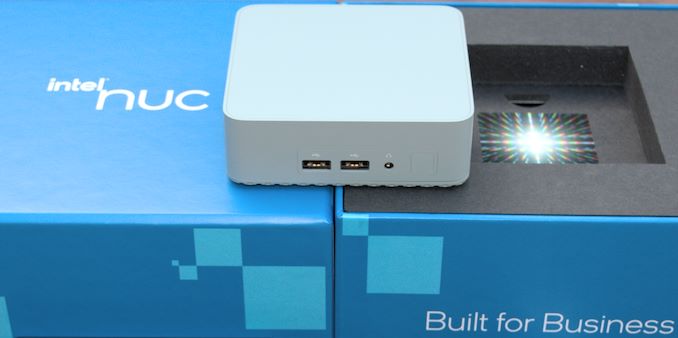
NUC12WSKv7 - An Updated Chassis Color Scheme
The new case design above is a preview of the plans for future 4x4 NUC models. The perforated case bottom can be removed without the aid of any tools to get access to the underside of the system (for the installation of the RAM and SSD).
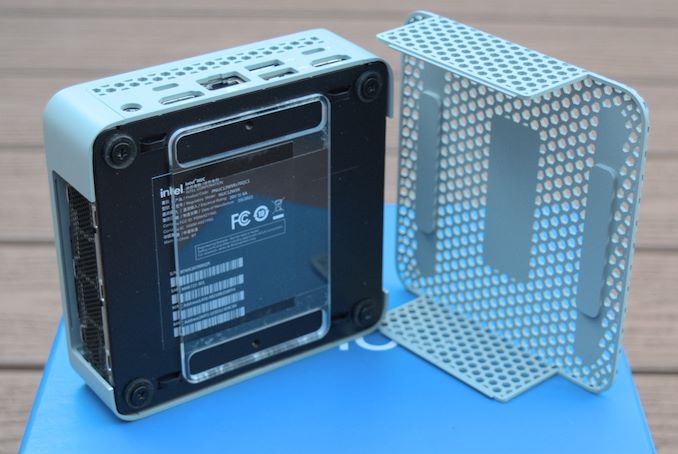
NUC12WSKv7 - 4x4 Designer Version Preview
The third NUC model is the Bleu Jour Meta 12. The Meta series of fanless systems from Bleu Jour is geared towards industrial applications. The Meta 12 uses the Lite board - the NUC12WSBi70Z - which does away with the Type-C ports. A key difference is the presence of a DC power input connector in addition to the regular power adapter connection.
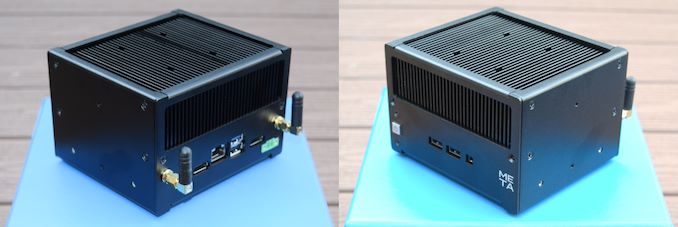
Bleu Jour Meta 12 (NUC12WSBi70Z) Fanless Rugged Industrial PC
The gallery below presents additional photographs of the internals of the above three systems.
The full specifications of the normal and vPro review samples are provided in the table below. The Bleu Jour Meta 12 is essentially the same as that of the NUC12WSKi7, except for the absence of the two Thunderbolt 4 Type-C ports.
| Systems Specifications (as tested) |
||
| Intel NUC12WSKi7 (Wall Street Canyon) | Intel NUC12WSKv7 (Wall Street Canyon vPro) | |
| Processor | Intel Core i7-1260P Alder Lake 4P + 8e / 16T, up to 4.7 GHz (P) / 3.4 GHz (e) Intel 7, 18MB L2, 28W (PL1 = 40W, PL2 = 64W) |
Intel Core i7-1270P Alder Lake 4P + 8e / 16T, up to 4.8 GHz (P) / 3.5 GHz (e) Intel 7, 18MB L2, 28W (PL1 = 40W, PL2 = 64W) |
| Memory | Crucial CT16G4SFRA32A.C16FR DDR4-3200 SODIMM 22-22-22-52 @ 3200 MHz 2x16 GB
|
Crucial CT16G4SFRA32A.C16FR DDR4-3200 SODIMM 22-22-22-52 @ 3200 MHz 2x16 GB
|
| Graphics | Intel Iris Xe Graphics (96EU @ 1.40 GHz) |
Intel Iris Xe Graphics (96EU @ 1.40 GHz) |
| Disk Drive(s) | Kingston KC2500 SKC2500M8500G (500 GB; M.2 2280 PCIe 3.0 x4 NVMe;) (Kioxia BiCS4 96L 3D TLC; Silicon Motion SMI 2262EN Controller) |
Kingston KC2500 SKC2500M8500G (500 GB; M.2 2280 PCIe 3.0 x4 NVMe;) (Kioxia BiCS4 96L 3D TLC; Silicon Motion SMI 2262EN Controller) |
| Networking | 1x 2.5 GbE RJ-45 (Intel I225-V) Intel Wi-Fi 6 AX211 (2x2 802.11ax - 2.4 Gbps) |
1x 2.5 GbE RJ-45 (Intel I225-LM) Intel Wi-Fi 6 AX211 (2x2 802.11ax - 2.4 Gbps) |
| Audio | Digital Audio with Bitstreaming Support over HDMI Ports 3.5mm stereo headset jack (Realtek audio codec) |
Digital Audio with Bitstreaming Support over HDMI Ports 3.5mm stereo headset jack (Realtek audio codec) |
| Video | 2x HDMI 2.0b 2x Display Port 1.4a with HBR3 over Thunderbolt 4 |
2x HDMI 2.0b 2x Display Port 1.4a with HBR3 over Thunderbolt 4 |
| Miscellaneous I/O Ports | 2x USB 3.2 Gen 2 Type-A (Front) 1x USB 3.2 Gen 2 Type-A (Rear) 1x USB 2.0 Type-A (Rear) 2x Thunderbolt 4 (Rear) (Type-C) |
2x USB 3.2 Gen 2 Type-A (Front) 1x USB 3.2 Gen 2 Type-A (Rear) 1x USB 2.0 Type-A (Rear) 2x Thunderbolt 4 (Rear) (Type-C) |
| Operating System | Windows 11 Enterprise (22000.1455) | Windows 11 Enterprise (22000.1516) |
| Pricing | (Street Pricing on January 25th, 2023) US $660 (barebones) $843 (as configured, no OS) |
(Street Pricing on January 25th, 2023) US $827 (barebones) $1010 (as configured, no OS) |
| Full Specifications | Intel NUC12WSKi7 Specifications | Intel NUC12WSKv7 Specifications |
In the next section, we take a look at the BIOS options along with an analysis of the motherboard platform. Following that, we have a number of sections focusing on various performance aspects before concluding with an analysis of the value proposition of the systems.


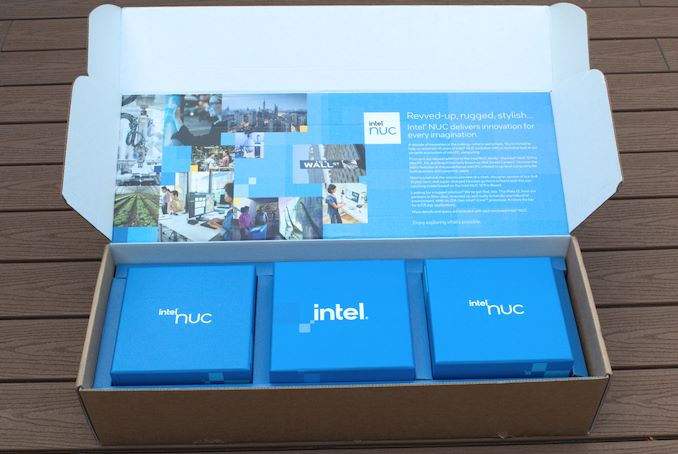
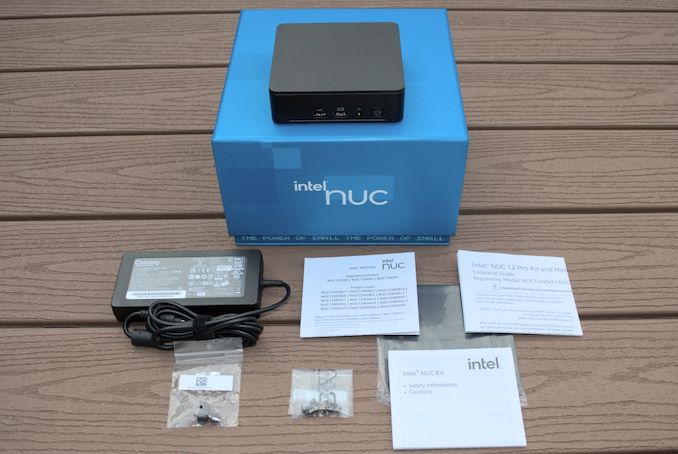














25 Comments
View All Comments
abufrejoval - Sunday, January 29, 2023 - link
In the PC market, even "small" niches seem to be big enough to merit a product, otherwise Intel wouldn't keep on doing them.My main NUC use case is µ-servers in a 10Gbit cluster using cheap cascaded KVMs in the rare case I need the console. Near silent and low average power 24x7 operation is the goal, with enough peak power to get things done in a hurry.
Yes, you could build that from laptops, but unfortunately the ones that offer 64GB RAM and 2-8TB of NVMe as well as a TB port for 10GBit Ethernet are designed for gamers and carry quite a hefty premium and extras I don't need.
In corporate workplaces laptops have pretty much replaced small form factor PCs, even more so with the pandemic. But there are still quite a lot of profesisonal installations in public services, medical care and production, where NUCs mounted to a firmly attached display are quite the ticket.
Personally, I'd prefer to have Mini-ITX board variants for every NUC Intel builds, but that really seems too niche these days.
ottonis - Friday, March 17, 2023 - link
A NUC can be a tremedously useful device to power up a basic digital audio workstation (DAW), alongside external audio and midi devices. It has enough processing power to run even the most modern DAW (e.g. studio one) alongside a bunch of virtual instruments and effects. Once everything is installed and up and running, it may be useful to deactivate Wifi, Bluetooth and LAN and to purge the autostart menu from all but the most essential scripts and programs, in order to reduce DPC latency.It is so compact that it a dream come true for musicians wanting to save precious space in the homerecording studios or who are on the run and on tour and need to travel as light as possible.
So, if you know how to set this device up, it is an invaluable tool for musicians.
It's benefit over laptops: it has more I/O. I struggled to connect all my external devices with an otherwise great laptop, but the NUC can handle them all (4x USB-A + 2x USB-C)
CyrIng - Saturday, January 28, 2023 - link
The blue carton box has a better look than the NUC case.About Hybrid processors, CoreFreq is now monitoring Pcore and Ecore, including their own Turbo tunable tweaks
ISO available at www.cyring.fr
abufrejoval - Sunday, January 29, 2023 - link
The GPU-Z data is obviously bollocks: I was first thrown off by the low memory bandwidth of 25GB/s, which is really what DDR3 based GT3 solutions or single channel DDR4 might do (64-bit width may be another hint, because it's 128-bit on dual channel).I am seeing more like 40GB/s on my various Xe's, 38.4GB/s on an i7-1165G7 and 42GB/s on an i5-12500H with an 80EU Xe, both using DDR4-3200 SO-DIMMs.
But it's the pixel and texture fill rates and the GPU boost clocks where things must have been read wrong, nothing clocks 11GHz on CMOS just yet and the fill rates are matching the RTX2060 on my NUC11PHBi7 using GDDR6, 10GPixels and 21 GTexels are more realistic with 1.3GHz boost.
So please recheck the setup and data.
abufrejoval - Sunday, January 29, 2023 - link
It's too bad how Intel often just manages to get withini >90% of what I want, only to bungle it on the final stretch...The "blue day meta" variants (what on Earth did they smoke?) are rather intriguing because they seem to allow screwing say a Noctua fan on top (is there a matching fan connector on the board?): that could fix the major isse with the NUCs, too little volume/mass for cooling 20-30 Watts at acceptable noise levels.
What's critically missing for me, is the Thunderbolt ports, which I need for 10GBit networking, be it via Ethernet or TCP over TB. I believe those parts may still be in short supply, but I'd always pay €20-30 extra to have those ports.